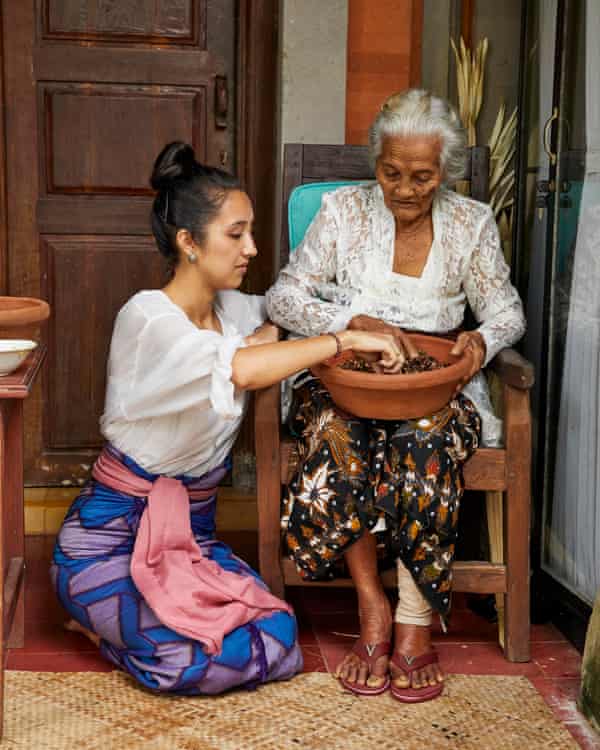
It’s five o’clock in the morning. My niang (grandmother) is bent over her mudbrick stove with a bamboo pole in her right hand, stoking the freshly lit fire. “It’s better to fill your mind with nice thoughts when you’re cooking,” she says.
My niang and I have been cooking together for four years now. Our conversations in her kitchen – a traditional open-air pavilion with a wood-fired cooktop – are what brought me home to Bali.
Before that, I’d spent most of my life in Australia writing about nearly every other cuisine under the sun. On my trips home, I’d head straight for my niang’s cooking – her smoke-tinged rice, delicate broths and flavour-packed sambals – and I’d wonder why the rest of the gastronomic world paid so little attention to Balinese food.
I now understand why. My niang’s generation learned and passed down knowledge orally, so the best recipes are rarely recorded on paper, and restaurants seldom have the time and tools to match the depth, complexity and zing of Bali’s home kitchens. So Balinese flavours have flown under the culinary radar, unexplored, for the most part, by chefs, food publications and hungry travellers. These recipes, I hope, will change that.
Sambal matah (raw sambal with lemongrass)
This sambal is similar to a salsa. It’s probably Bali’s best-loved condiment and every region, village and household adds their own twist to it. Slice the ingredients as finely as possible and use your fingers to do the mixing.

Makes 250g
150g (approximately 6) red (Asian) shallots, finely sliced
18 tabasco chillies, finely sliced
4 lemongrass stems, white part only, finely sliced
6 lime leaves, finely chopped
80ml coconut oil
1 tbsp lime juice
2 tsp shrimp paste, lightly fried
Sea salt, to taste
Using your hands, toss the shallot, chilli, lemongrass and lime leaves together in a medium mixing bowl.
Heat the coconut oil in a small saucepan over a medium heat for three to four minutes and pour it into the mixing bowl.
Let the mixture cool slightly, and, using your hands, gently squeeze everything together to incorporate the coconut oil into the other ingredients.
Add the lime juice and shrimp paste and toss again. Season with salt to taste and you’re ready to go. Best eaten fresh, not stored.
Urab timun (cucumber and burnt coconut salad)
This cucumber number normally comes out on special occasions. You can reduce or even leave out the chillies for less heat if you prefer.
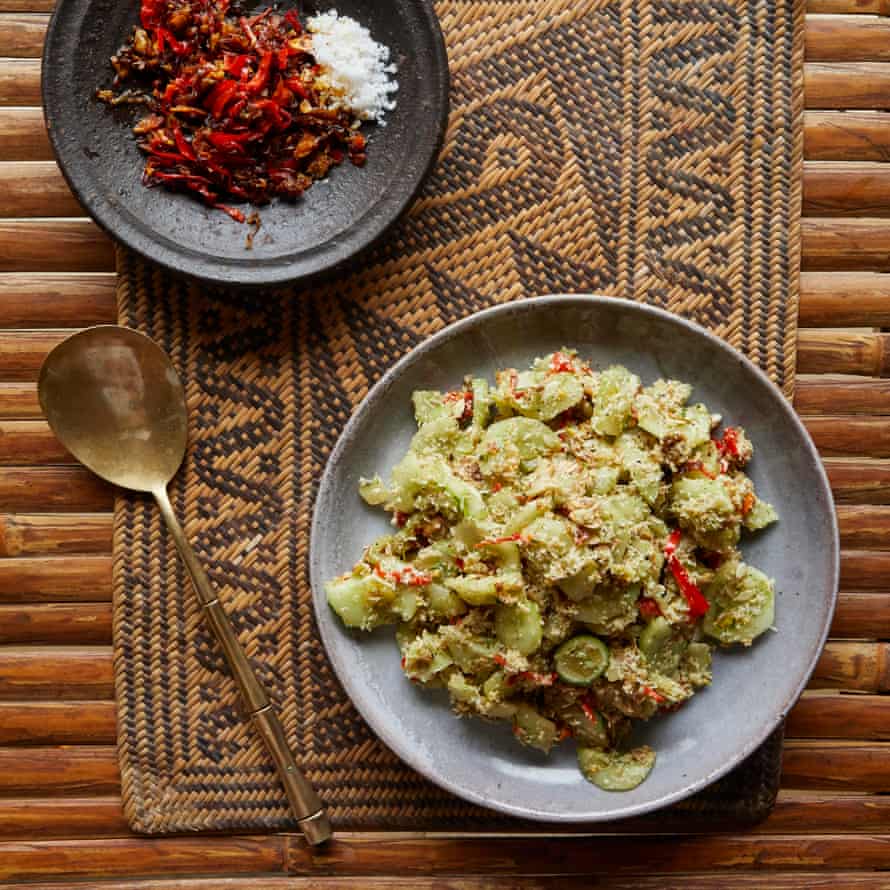
For the salad
220g roasted coconut, finely grated
4 cucumbers, peeled, halved lengthways and sliced
Sea salt, to taste
4 lime leaves, finely sliced, to serve
Juice of ½ lime, to serve
For the sambal
4 tbsp coconut oil
4–5 red (Asian) shallots, finely sliced
5 garlic cloves, finely sliced
6 red bird’s eye chillies, finely sliced (optional)
1 tsp shrimp paste, rolled into a ball
Thumbnail-sized piece of lesser galangal, finely chopped
1 tsp salt
To make the sambal, heat the oil in a small wok over a medium heat. Add the shallots and fry for two minutes, or until they become translucent. Add the garlic and fry, stirring constantly to make sure nothing sticks or burns, for four minutes, or until the garlic and shallots have gently caramelised.
Add the chilli, shrimp paste and lesser galangal and cook, stirring, until the shrimp paste is completely dissolved, the chilli is wilted and the lesser galangal becomes fragrant. Add the salt and stir again, then take off the heat.
Pour most of the sambal into a bowl, setting about a handful aside for seasoning, and combine it with the coconut using your fingers.
Add the cucumber and some of the coconut mixture to a large bowl and toss together using your hands. Massage it well but be careful not to bruise the cucumber too much, adding more coconut mixture until you’re happy with the cucumber-to-coconut ratio. The cucumber should be nicely coated but not too soggy.
Season with salt to taste and more sambal for extra kick, if you like. Top with the lime leaves and a squeeze of lime juice and enjoy immediately.
Pepes be pasih (spiced snapper grilled in banana leaves)
Pepes be pasih is insanely popular all across Bali, particularly in the coastal areas where you can easily get your hands on fresh seafood. For this recipe, I’ve chosen snapper because this is what we ate growing up. My mother also made this recipe using albacore tuna and octopus, which you should certainly try, too. It’s one of my favourite ways of cooking seafood, as the banana leaf holds all the moisture in, the charcoals provide smokiness and the spices bring punch, heat and colour to the dish.
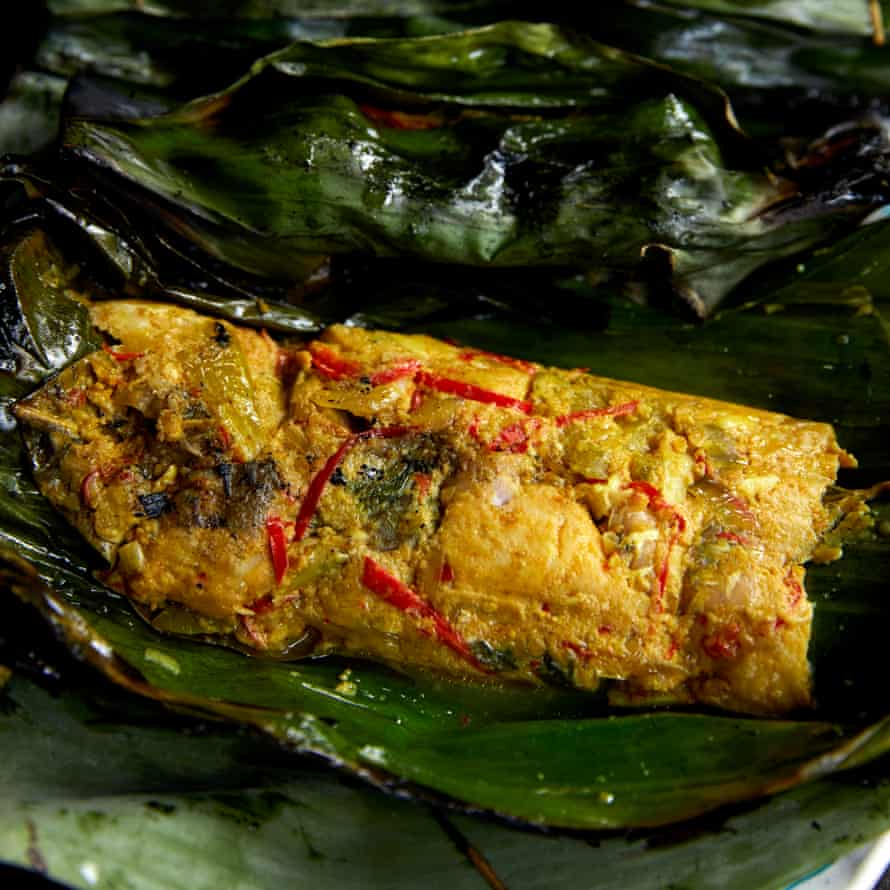
Serves 2
100g banana leaves, cut into 20 × 22 cm sheets
Toothpicks
1 tsp palm sugar, chopped
100g base kuning, recipe below
300g snapper fillet, cut in half
1 tsp sea salt
2 tbsp coconut oil
2–3 red (Asian) shallots, sliced
6 garlic cloves, sliced
1 long red chilli, seeded and sliced
2 salam leaves
1 small bilimbi or green tomato, finely sliced
2 sprigs carum (lemon basil)
Steamed rice, to serve
Urab timun, to serve, above
Sambal matah, to serve, above
Add the sugar and base kuning to a small mixing bowl and use your hands to massage them together until completely combined.
Season the fish with the salt and add it to the base mixture. Transfer the fish to the fridge to marinate for 30 minutes.
Heat the oil in a medium saucepan over a medium heat. Add the shallot and garlic and sauté for three to four minutes, or until translucent, being careful not to let anything stick or burn. Set aside to cool, then toss with the chilli. Once cool enough to handle, massage the marinated fish with the shallot mixture.
Preheat a charcoal grill or barbecue.
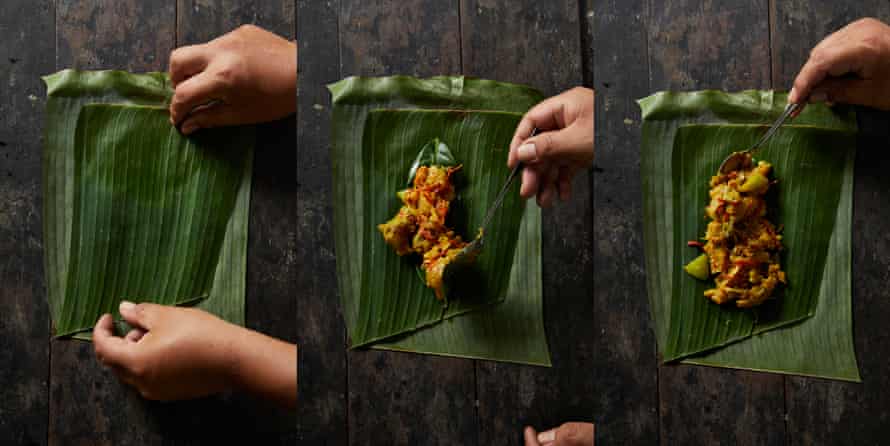
To make a banana leaf parcel, place two pieces of banana leaf on top of each other, with the bottom leaf ’s top (glossy) side facing the bench and the top leaf ’s glossy side facing you. The veins of both leaves should face in the same direction.
Place a salam leaf in each parcel, lay the fish on top, then place a slice of bilimbi or green tomato and carum on top.
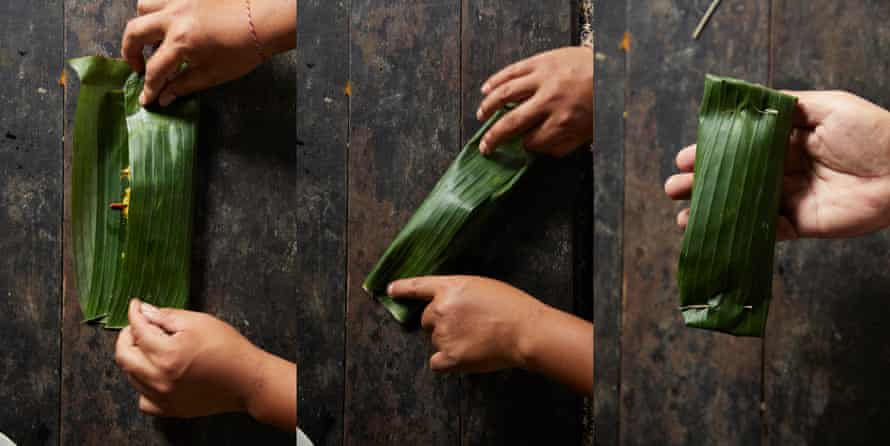
Fold one side of the banana leaf over the fish, going with the grain of the leaf.
Fold the other side of the leaf over in a letter fold.
Fold over both ends and fasten them with toothpicks or traditional bamboo sticks.
Grill the parcels over a medium heat for about eight minutes on each side – the banana leaf should get a little charred as the fish steams inside.
Carefully unwrap the parcel over a bowl to catch all the juices.
Place the meat on a plate, pour over the juices and serve with steamed rice, a side of urab timun and sambal matah.
Base kuning (yellow spice paste)
The word base (pronounced bah-surr) refers to spices or mixtures of spice. Base combinations are best made fresh, but you can make them in bulk and store them in the freezer.
The traditional art of hand-working your food adds a rhythmic element to the cooking. We also believe it connects the cook and the ingredients on an energetic level, where the dish becomes an offering laced with love and intention. So skip the food processor (as tempting as it might be).
Makes 450g
15 cm piece fresh turmeric, roughly chopped
115g fresh lesser galangal, roughly chopped
1 cm piece fresh ginger, roughly chopped
115 g (approximately 30) garlic cloves, roughly chopped
1 red (Asian) shallot, roughly chopped
3 candlenuts, roasted and roughly chopped
9 tabasco chillies, roughly chopped
100ml coconut oil
250ml water
2 tsp sea salt
1 tsp sugar
Using a large mortar and pestle, crush the turmeric, lesser galangal, ginger, garlic, shallot, candlenuts and chillies into a paste. Most Asian supermarkets stock candlenuts, and you can buy them online – or substitute for their relative, the macadamia nut.
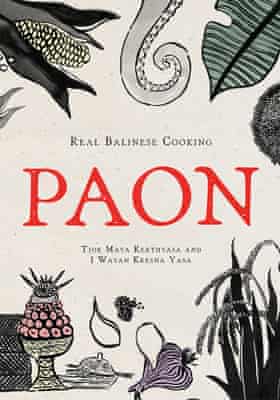
Heat the oil in a wok over a high heat until it reaches smoke point. Turn the heat down to medium, add the spice paste and slowly stir in the water over two minutes.
Reduce the heat to low and continue cooking the paste for 45 minutes to one hour, or until all the liquid has evaporated and it forms a deep-yellow paste.
Add the salt and sugar, give it a good stir and cook over a low heat for a further 10 minutes. Adjust the seasoning to taste. It’s ready when it’s dark yellow in colour with a bright aroma and a punchy, earthy flavour. Store in an airtight container in the fridge for two to three weeks.
-
This is an edited extract from Paon: Real Balinese Cooking by Maya Kerthyasa and Wayan Kresna Yasa, published by Hardie Grant Books (RRP$50). Photography by Martin Westlake



